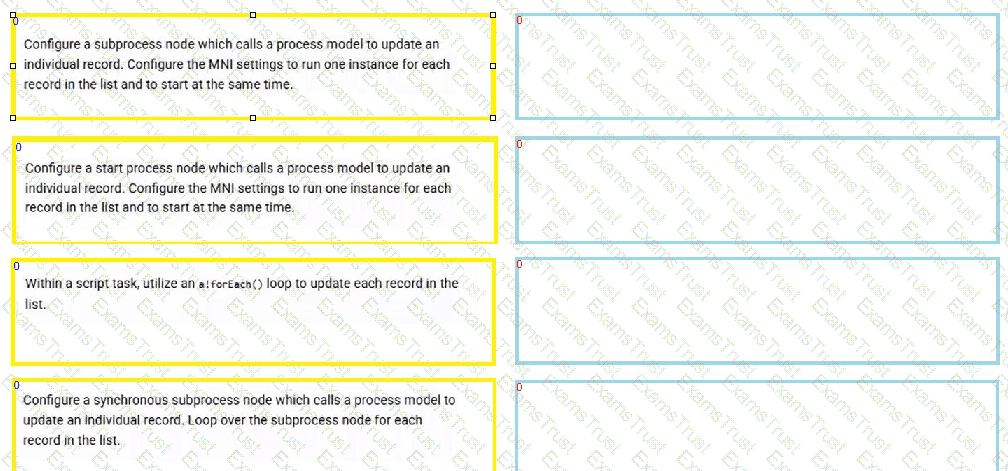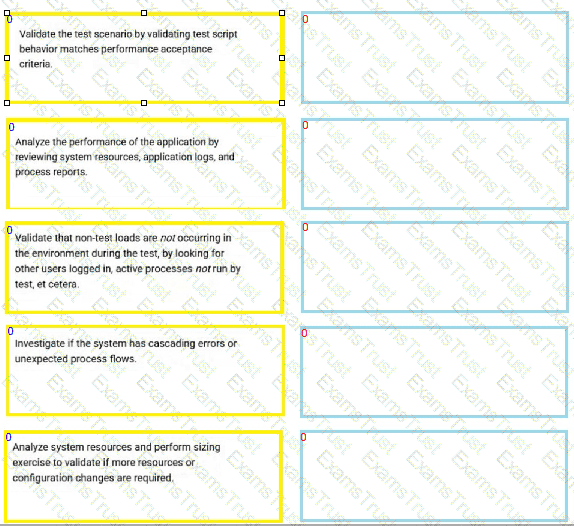A process was recently pushed to the Prod environment. However, users are reporting that a task on this process is experiencing slow response times when they try to input data.
What is the most likely reason for this issue?
You need to configure the security for the synced record type Case.
Your requirements are:
Only users in the "Archive Management" group can access cases in the "Archived" status.
Cases in the status "Deleted" are accessible to no one.
Users in the "All Users" group can already access the record.
What should you do?
You're redesigning user interfaces to achieve more efficient space usage.
Which layout component is the best choice for displaying an interface with a vertical meaningful order of components?
You're creating a process to update specific fields in a list of records and you save the updated records to the database.
You're given the following performance considerations:
 Execution time
Execution time
 Process instance memory usage
Process instance memory usage
 Process execution engine load balancing
Process execution engine load balancing
Based on these performance metrics, rank the options from best to worst.
Note: To answer, move all steps from the Options list to the Answer List area and arrange them in the correct ranking order (best at the top, and worst at the bottom).

You're building an application with a review workflow.
Each submission must be approved by three users who can each approve or reject their request, and leave a comment. This action changes the status of the submission to 'Approved' or 'Rejected' correspondingly, and pushes the review to the previous or next assignee.
Which data model captures the workflow requirements appropriately?
You need to allow external systems to invoke Appian web APIs.
Which user role should be assigned?
You're the administrator of your insurance company’s case management system. You need to limit insurance agents to only those clients to which they have been assigned.
Which two statements must be true for one way to configure Record-Level security for the Customer record? (Choose two.)
There are two record types, ABC and XYZ, with sync enabled. The XYZ record type is added as a relationship into the ABC record type.
A user has Viewer permission to the ABC record type but does not have access to the XYZ record type.
A site page is presented to the user where the data is sourced from the ABC record type and its related record type the XYZ reference.
What information does the user see on the site page?
An application consists of a record type with sync enabled. This record type is used as a source to create a read-only grid.
A field "Number of days since created" is configured in the interface and a logic is implemented to calculate the number of days since a record is created in the application.
You need to implement sorting on this field.
What should you do?
You need to select a plug-in to meet a specific requirement and several plug-ins can do the job.
What are three key factors to consider? (Choose three.)
You need to configure your process model to store the result of an expression rule for every item in a list. Your design must have the smallest memory footprint.
What should you do?
You're executing a performance test of the client's application. You notice that server-side resources are at high-to-critical operating levels.
What should you do to troubleshoot this issue?
Note: To answer, move all steps from the Options list to the Answer List area and arrange them in the correct order.

You're developing a functionality to manage transactions for an insurance company. Each transaction can have multiple items where respective item type and item amount can be entered. The amount entered can be either negative or positive, and is a decimal data type with a precision of 8 and a scale of 2.
A maximum of 10 items can be entered for a transaction. Once all the items are entered, you need to calculate and show the sum of all items' total amounts at the transaction level.
What is the best way to calculate and display the sum of all item amounts?
You're creating an interface to display all the employees of a company on a staff list.
You decide to use a!gridField() to create a user grid to display information from the company's AAA_Employee record, which has 42 fields relating to various employee information. To avoid cluttering the grid, you want to show six (6) fields on the grid.
How should you optimize the interface?
What are three ways to optimize the memory usage of a process model? (Choose three.)
Which two options are correct regarding record relationships when using synced records in your application? (Choose two.)
You notice that a process consumes a significant amount of memory. The process involves ingesting long strings from a web service and saving them to the database using a looping approach. The string output is saved to a process variable with data type Text.
Which two options will reduce the memory usage? (Choose two.)
You’re designing a file upload process that integrates with an external document management system.
Part of this process is to develop a start form with a file upload component, so that the user can upload multiple files.
The business has requested that the maximum file size that can be uploaded through this process is 1GB. Additionally, you’re aware that the integration's API can accept files with a maximum file size of 3GB, but recommends no larger than 1GB.
Can the process be more performant without straining the application or integration?
What are two advantages of database normalization? (Choose two.)
You're inspecting the items in a deployment package for issues you might have missed during package preparation.
Which two objects can be in your list of missing precedents for an application? (Choose two.)
You receive a warning about approaching the 2,000,000 row limit with synced records in your Production environment.
What are two ways to efficiently address this warning to prevent reaching the limit? (Choose two.)
You need to create a web API so that an external system can start a process in your app.
Which two statements are true about using a service account to authenticate the system? (Choose two.)
You're building an order management system.
You need to create a field that displays the total number of days it took to deliver each order, and show and sort by this data in a read-only grid. The data must be available in real-time.
Which function is the most appropriate for calculating this value?
You have set up SAML for single sign-on (SSO) in your cloud environment.
Which three options could you enable in the Attribute Mapping section of the Admin Console to sync with a user's profile in Appian? (Choose three.)
Which step should you perform to identify expression rules that have been causing or have caused performance issues in the past 30 days?
You need to display information for pending tasks for each individual in an application. The tasks may be for a single specific application.
Which context type should you select for the Task Report Type?
You need to implement a Gender dropdown, where the choice labels may need to be altered in the future. The transactional database tables rely on this data for reporting, so the data must be accurate.
What is the recommended action?
The synced record Task has a self-referential relationship defined in the column parentTaskId. There is a many-to- one record relationship between the id and parentTaskId called parentTask.
For a given task ID, you need to return the task name and the parent task name.
What should you do?
You're conducting a code review and notice that some accessibility features are missing on the interfaces.
Which two UX best practices should be followed to align with accessibility requirements? (Choose two.)